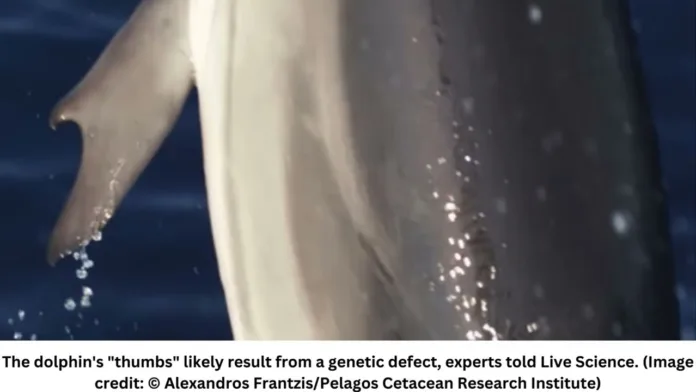Gulf of Corinth unveils peculiar flipper morphology – a genetic quirk or evolutionary oddity?
In a twist of marine marvel, scientists have stumbled upon the first-ever dolphin sporting ‘thumbs,’ sending shockwaves through the scientific community. The enigmatic discovery comes from the azure waters of the Gulf of Corinth off the Greek coast.
Captured in recent photographs released by the Pelagos Cetacean Research Institute, the peculiar dolphin exhibits hook-shaped ‘thumbs’ on its flippers, a feature never observed in the cetacean world before. Researchers, baffled by the anomaly, spotted the unique marine creature during boat surveys this summer.
Despite its distinctive flipper morphology, the dolphin seamlessly integrated with its pod, engaging in activities typical of its species. Alexandros Frantzis, the scientific coordinator and president of the Pelagos Cetacean Research Institute, expressed his astonishment, stating, “It was the very first time we saw this surprising flipper morphology in 30 years of surveys in the open sea and also in studies while monitoring all the stranded dolphins along the coasts of Greece for 30 years.”
The Gulf of Corinth, known for its diverse marine species, hosts around 1,300 striped dolphins, including the one with the extraordinary ‘thumbs.’ However, the newfound dolphin’s flipper stands out significantly, suggesting potential genetic irregularities due to inbreeding.
Frantzis proposes that the ‘thumbs’ may be a result of the expression of rare and ‘irregular’ genes, leading to this unprecedented phenomenon. Lisa Noelle Cooper, an associate professor of mammalian anatomy and neurobiology, supports this theory, stating, “I’ve never seen a flipper of a cetacean that had this shape.”
Cooper believes the ‘thumbs’ could be attributed to an altered genetic program shaping the flipper during the dolphin’s development as a calf. While the hook-shaped ‘thumb’ may contain bone, it remains non-mobile. Remarkably, the dolphin seems to thrive despite its extraordinary features.
Fortunately for humans, these ‘thumbs’ lack opposability, sparing us from a marine mammalian overthrow. As a 2017 study suggests, dolphins already stand virtually on par with humans for ‘planetary dominance.’ One can only wonder at the mysteries hidden beneath the waves, as this unconventional dolphin introduces a new chapter in marine biology.
